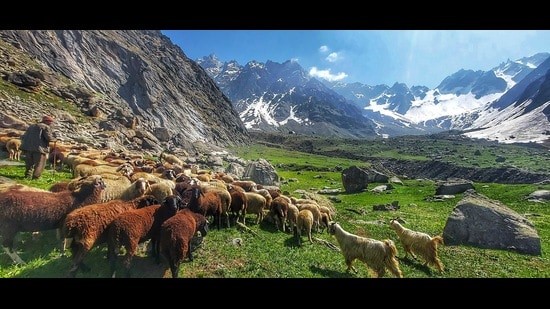Description

Disclaimer: Copyright infringement not intended.
Context
- In Himachal Pradesh atleast 60 sheep and goats died and another 250 fell sick due to a viral disease named Peste Des Petits Ruminants.
- Currently In highland pastures of Lahaul-Spiti, animal husbandry authorities are taking stock of situation to control the spread of this contagious disease.
Other Details
- Authorities are collecting samples and sending them for further examination.
- An awareness raising programme among shepherds is being undertaken to sensitize them about this deadly disease in a bid to reducing the mortality rate.

Peste Des Petits Ruminants
- It is a highly contagious viral disease caused by morbillivirus.
- This virus belongs to the family paramyxoviridae.
- First identified in early 1940s in Ivory Coast, this disease is later reported from many African, Asian and European nations.
- In India highest instances of this disease are reported from Himachal Pradesh.
- Other states are Andhra Pradesh, West Bengal, Telangana, Karnataka and Chhattisgarh.
- Morbidity rate in affected animals can go up to 90-100%.
Symptoms
- Diarrhoea.
- Pneumonia which affects the lungs.
- Blisters in the mouth.
- Respiratory issues.
- Lacrimation.
- Serous nasal discharge.
- Depression and anorexia.
Host animal
- Most prone animals are goats and sheep.
- In comparison to goats and white-tailed deer, Sheep are less susceptible to this virus.
- Other species also host this virus, however is less prevalent, such as antelope and wild relatives of domesticated small ruminants like gazelles, bushbuck, impala, springbuck, gemsbok, bharal.
- Some species like goitered gazelle, African grey duiker, Bubal hartebeest, waterbuck, kob and African buffalo are also found infected by this
Transmission
- It happens mainly through respiratory route and spread by airborne droplets which travel to a short distance.
- Direct contact between immuno-naïve animals with other animals living in close quarters.
- A short term infection due to fomites such as such as pasture and water troughs, feed and bedding Feeding in a group.
- High local movement in a particular season.
- More research is needed to understand its transmission in other species, such as camels and antelope.
Impact on health
- Aggrieved situation of bronchopneumonia.
- Dehydration.
- Abortion risk to pregnant females.
- Reduction in milk yield.
- Death.
Inactivation of virus
- Temperatures above 70°C.
- 6 < pH < 5.6.
- Can also be inactivated using disinfectants such as sodium carbonate, sodium hydroxide, sodium hypochlorite, alcohols etc.
- Range of incubation period is 2 to 10 days.
Treatment
- No specific treatment for PPR is available as of now.
- Supportive care.
- Symptomatic treatment of bacterial and parasitic infection.
- Preventive measures.
Current Situation in Lahaul and Spiti
- Symptomatic treatment is being administered for sick animals.
- Sample for diagnosis are being sent to Regional Disease Diagnostic Laboratory, Jalandhar and other labs.
- Vaccination of animals is being planned.
- Veterinary pharmacists are present at the spot for the treatment of affected cattle.
|
PRACTICE QUESTION
Consider the following statements about Peste des petits ruminants:
1. It is caused by a virus named morbillivirus.
2. In India highest cases are reported from Kerala.
3. In comparison to goats, sheep are more susceptible to this virus
Which of the statements given above is/are incorrect?
A. 1 and 2 only
B. 2 and 3 only
C. 1 and 3 only
D. 1,2 and 3
Answer: (B)
|

https://www.hindustantimes.com/cities/chandigarh-news/outbreak-of-highly-contagious-viral-disease-in-himachal-pradesh-s-lahaul-spiti-kills-60-sheep-and-goats-101688577630018.html












